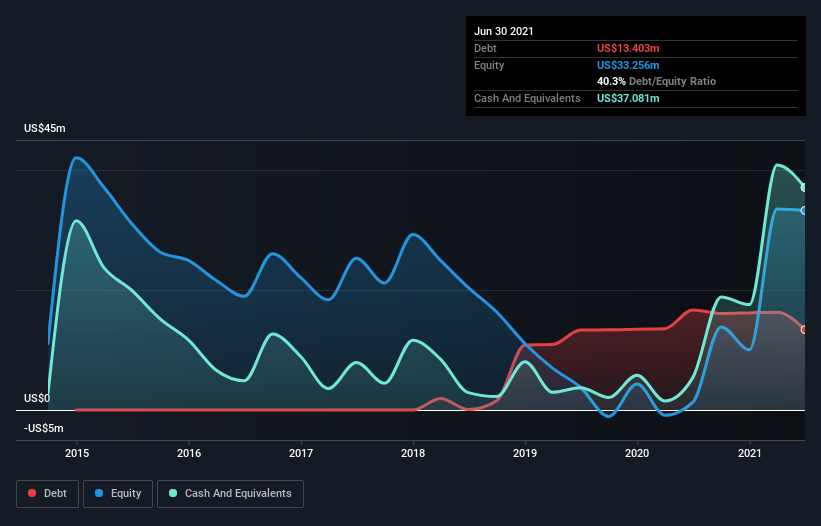Health Check: How Prudently Does BIOLASE (NASDAQ:BIOL) Use Debt?
Some say volatility, rather than debt, is the best way to think about risk as an investor, but Warren Buffett famously said that 'Volatility is far from synonymous with risk.' It's only natural to consider a company's balance sheet when you examine how risky it is, since debt is often involved when a business collapses. We note that BIOLASE, Inc. (NASDAQ:BIOL) does have debt on its balance sheet. But should shareholders be worried about its use of debt?
Why Does Debt Bring Risk?
Debt assists a business until the business has trouble paying it off, either with new capital or with free cash flow. Part and parcel of capitalism is the process of 'creative destruction' where failed businesses are mercilessly liquidated by their bankers. However, a more common (but still painful) scenario is that it has to raise new equity capital at a low price, thus permanently diluting shareholders. Having said that, the most common situation is where a company manages its debt reasonably well - and to its own advantage. The first thing to do when considering how much debt a business uses is to look at its cash and debt together.
See our latest analysis for BIOLASE
What Is BIOLASE's Net Debt?
As you can see below, BIOLASE had US$13.1m of debt at June 2021, down from US$16.7m a year prior. However, its balance sheet shows it holds US$37.1m in cash, so it actually has US$24.0m net cash.
How Healthy Is BIOLASE's Balance Sheet?
According to the last reported balance sheet, BIOLASE had liabilities of US$12.7m due within 12 months, and liabilities of US$15.3m due beyond 12 months. On the other hand, it had cash of US$37.1m and US$3.82m worth of receivables due within a year. So it actually has US$12.9m more liquid assets than total liabilities.
This short term liquidity is a sign that BIOLASE could probably pay off its debt with ease, as its balance sheet is far from stretched. Simply put, the fact that BIOLASE has more cash than debt is arguably a good indication that it can manage its debt safely. The balance sheet is clearly the area to focus on when you are analysing debt. But ultimately the future profitability of the business will decide if BIOLASE can strengthen its balance sheet over time. So if you want to see what the professionals think, you might find this free report on analyst profit forecasts to be interesting.
In the last year BIOLASE wasn't profitable at an EBIT level, but managed to grow its revenue by 22%, to US$32m. With any luck the company will be able to grow its way to profitability.
So How Risky Is BIOLASE?
Statistically speaking companies that lose money are riskier than those that make money. And the fact is that over the last twelve months BIOLASE lost money at the earnings before interest and tax (EBIT) line. And over the same period it saw negative free cash outflow of US$14m and booked a US$32m accounting loss. Given it only has net cash of US$24.0m, the company may need to raise more capital if it doesn't reach break-even soon. BIOLASE's revenue growth shone bright over the last year, so it may well be in a position to turn a profit in due course. By investing before those profits, shareholders take on more risk in the hope of bigger rewards. The balance sheet is clearly the area to focus on when you are analysing debt. However, not all investment risk resides within the balance sheet - far from it. To that end, you should learn about the 3 warning signs we've spotted with BIOLASE (including 1 which doesn't sit too well with us) .
Of course, if you're the type of investor who prefers buying stocks without the burden of debt, then don't hesitate to discover our exclusive list of net cash growth stocks, today.
This article by Simply Wall St is general in nature. We provide commentary based on historical data and analyst forecasts only using an unbiased methodology and our articles are not intended to be financial advice. It does not constitute a recommendation to buy or sell any stock, and does not take account of your objectives, or your financial situation. We aim to bring you long-term focused analysis driven by fundamental data. Note that our analysis may not factor in the latest price-sensitive company announcements or qualitative material. Simply Wall St has no position in any stocks mentioned.
Have feedback on this article? Concerned about the content? Get in touch with us directly. Alternatively, email editorial-team (at) simplywallst.com.

